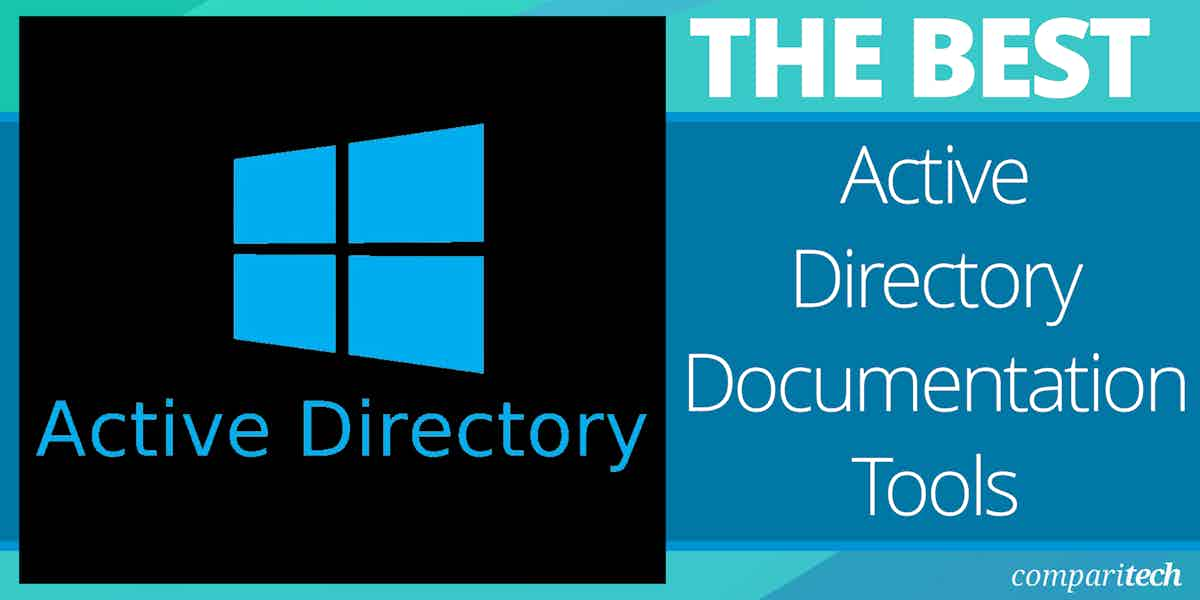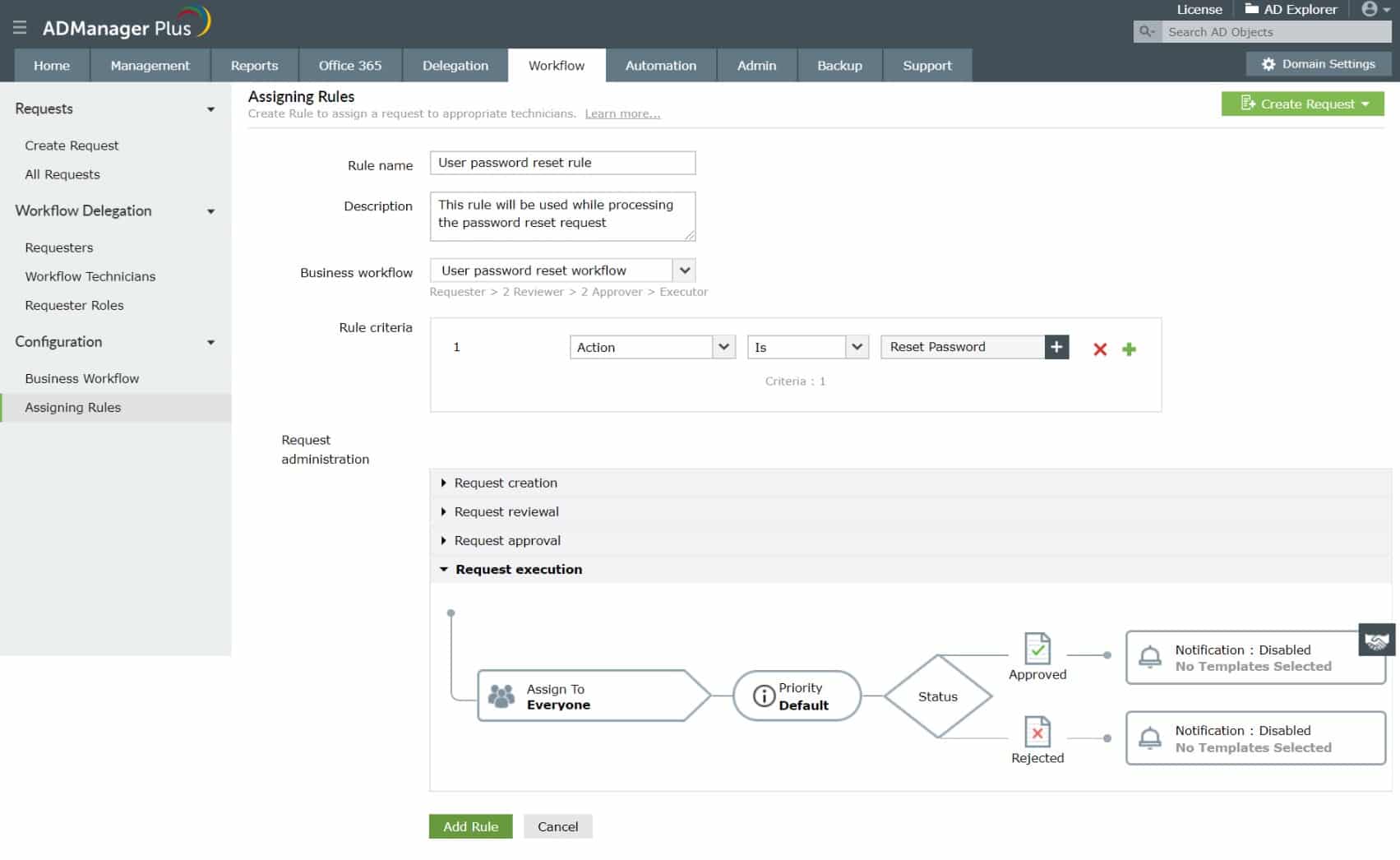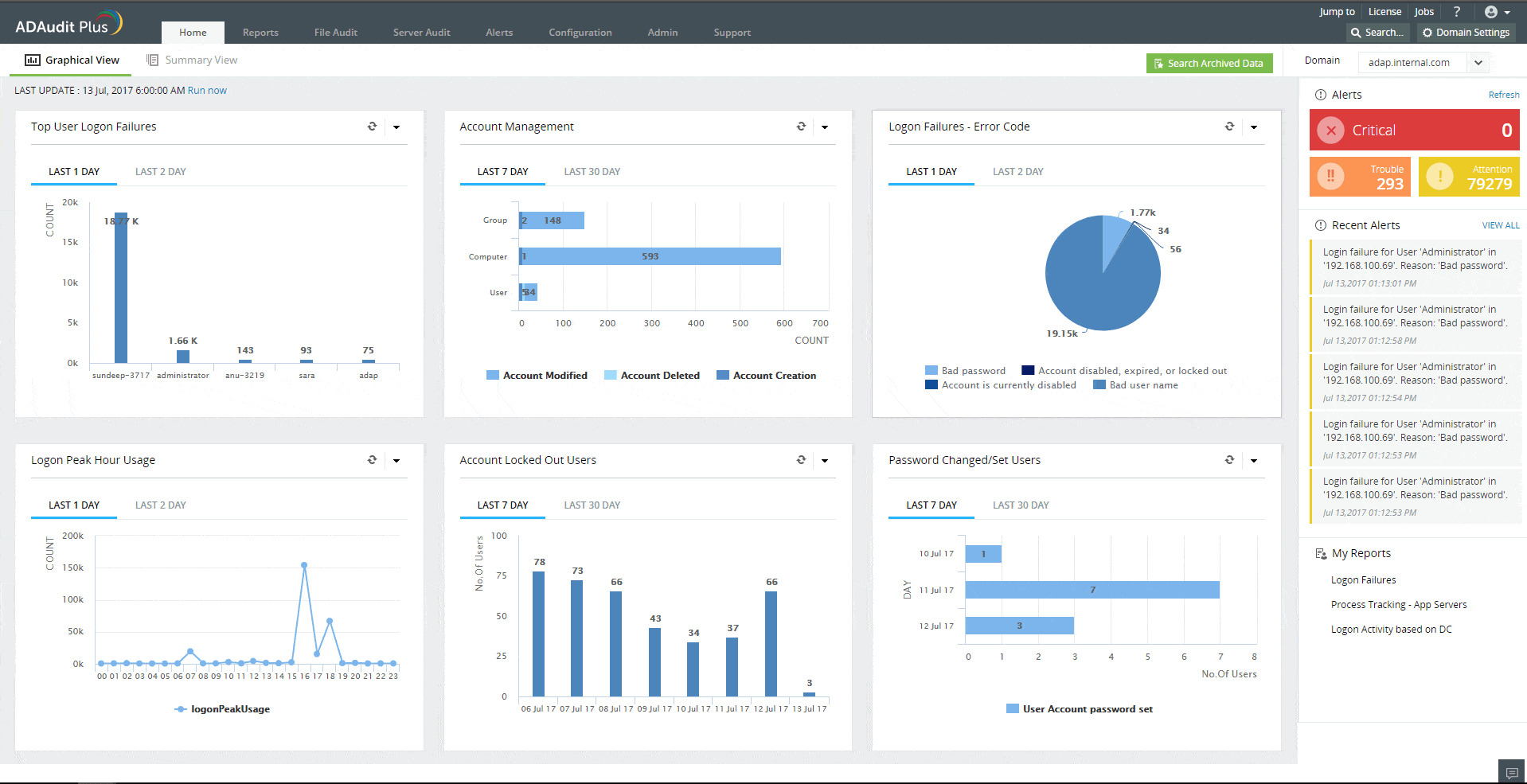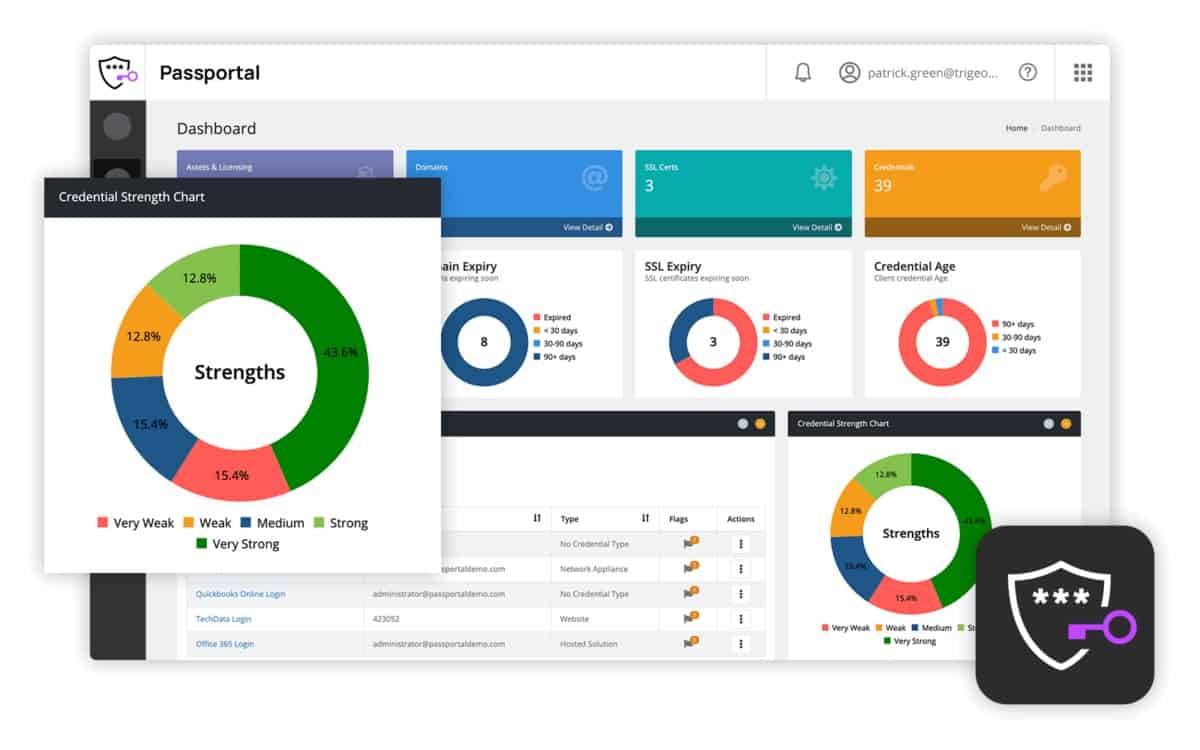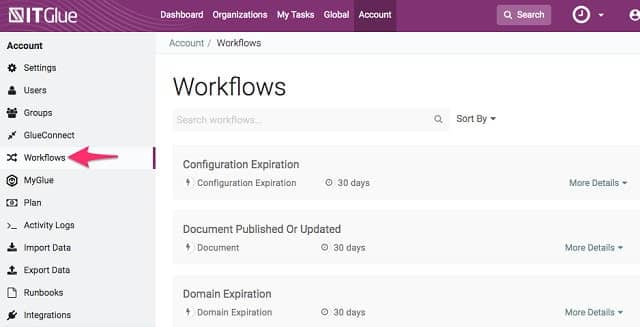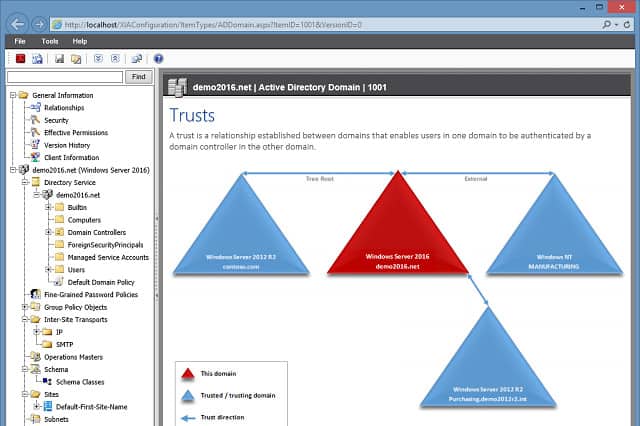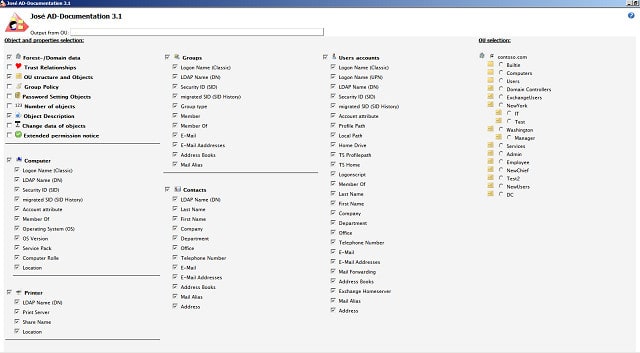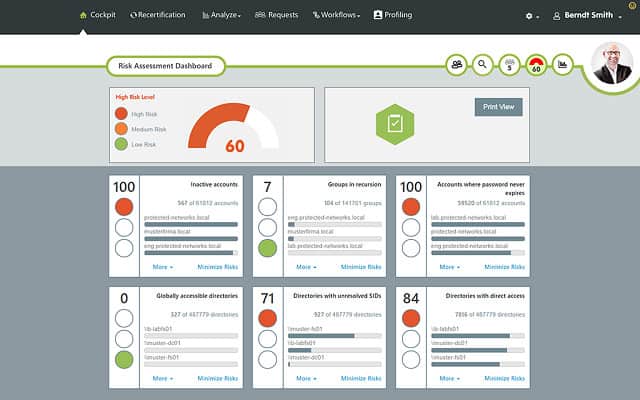Microsoft’s Active Directory is a very widely used access management system. It controls user accounts for Exchange Server, SharePoint Server, and just about every Microsoft product that requires user credentials. The service extends its competence out beyond the product catalog of Microsoft because it is used by many other software systems and guards access to network-connected devices.
Here is our list of the best AD Documentation tools:
- ManageEngine ADManager Plus EDITOR’S CHOICE On-premises Active Directory monitoring software that runs on Windows Server and Windows. Start a 30-day free trial.
- ManageEngine ADAudit Plus (FREE TRIAL) An activity tracking system that links to AD and records the events that occur on sensitive data, assigning those actions to specific users. Runs on Windows Server. Start a 30-day free trial.
- N-able Passportal An online IT documentation platform and password manager.
- IT Glue Cloud-based password manager and documentation management system.
- XIA Configuration An IT infrastructure documentation tool that includes an Active Directory monitoring module.
- José Active Directory Reporting A simple, free tool for recording AD controller statuses. Available as a command-line utility or with a GUI interface.
- Active Directory Report Builder An AD report query builder that displays results within the app and allows data to be exported.
- SolarWinds Access Rights Manager An Active Directory management system that includes a reporting module.
With so many uses of Active Directory, mastering control of the Active Directory system is very important for system administrators. The terminology of Active Directory can sometimes be a little confusing. Sometimes, busy people with lots of other responsibilities can get a little mixed up between domains, forests, and trees. Without having a clear idea of the divisions, the hierarchies, commonalities, and segregation of domain controllers and permission relationships, things can get messy.
Managing Active Directory
The only way to keep on top of the complicated relationships between users, devices, and the Active Directory implementation structure is to document it all.
Launching an Active Directory documentation project is a difficult task. A big decision to make is over the structure of the documentation. However, somebody who particularly needs to get the system documented to help foster better understanding and improve management probably won’t be able to think up a documentation structure.
Fortunately, there is guidance available on the correct format of an Active Directory documentation store.
See also: Best AD Management Software
Active Directory data security
Writing out how the domain controllers are organized and listing the permissions contained in them creates a second source of the Active Directory data. That information shouldn’t be proliferated and duplicating it outside of the secure environment of Active Directory increases risk.
The data contained in Active Directory needs to be kept confidential. Having that data lying around the office in printed documents or accessible as text documents somewhere on a company server creates a security weakness. So, the Active Directory information store needs to be secured with encryption and user credentials for access. For the sake of disaster recovery, the store of Active Directory documentation should be held away from the company’s primary site.
Active Directory auditing
As a centralized access rights manager, Active Directory is very important to data security standards compliance. In order to get certification for security protection standards such as PCI-DSS or HIPAA, a company needs to demonstrate that it has proper access rights management in place. Auditing for these standards and to supply proof in case of GDPR legal action requires Active Directory documentation.
The best Active Directory Documentation tools
You probably don’t have time to research all of the options for Active Directory documentation and auditing. This report has done the hard work for you, creating a shortlist for those looking to improve Active Directory management.
Our methodology for selecting Active Directory documentation tools
We reviewed the market for Active Directory documentation software and analyzed the options based on the following criteria:
- Secure storage for AD documentation with credential needed for access
- A query tool for exploring entries in Active Directory
- Utilities that enable you to assess account structures
- A system that highlights abandoned accounts
- Measures to analyze user group effectiveness
- An assessment period, such as a free trial
- Good value that is provided by a complete set if tools marketed at a reasonable price
You can read more about these tools in the following sections.
1. ManageEngine ADManager Plus (FREE TRIAL)
If you prefer to host your AD monitoring software on-site rather than accessing it at a cloud service, then ManageEngine ADManager Plus is probably your best option. This package is a very comprehensive interface to Active Directory and crucially, includes a reporting engine that will help you document your Active Directory implementations.
Key Features:
- Multi-Instance Management: Offers a robust interface for managing multiple Active Directory instances, including cloud and on-premises setups.
- Comprehensive Integration: Supports management and coordination across a variety of Microsoft products and Google Workspace.
- Enhanced Permissions Control: Aids in organizing user groups and refining permissions structures for better security.
Why do we recommend it?
ManageEngine ADManager Plus is a similar tool to SolarWinds Access Rights Manager because it provides a front ends for Active Directory and lets you manage and coordinate multiple instances for different Microsoft products, Google Workspace, and general system access. This system provides management for on-premises Active Directory and for Azure AD.
The reports generated by ADManager Plus cover users, distribution lists, security groups, computers, and contacts. It covers cloud-based AD implementations as well as onsite Active Directory statuses. The tool is also able to cover Exchange Server, Skype, and other applications that utilize Active Directory for access rights.
Who is it recommended for?
This system is suitable for most businesses but particularly those that run multiple DCs for different products. The system also includes an account auditing tool for PCI DSS, HIPAA, GDPR, and SOX compliance management. There is a Free edition for small businesses that is limited to managing 100 domain objects.
Pros:
- Extensive Reporting: Features a powerful reporting engine capable of generating detailed compliance reports for standards like PCI DSS, HIPAA, GDPR, and SOX.
- Versatile Support: Accommodates a wide range of domains and supports delegation, beneficial for NOC or helpdesk teams.
- Visual Permissions Overview: Allows for an intuitive understanding of share permissions and security group details, facilitating easier management.
Cons:
- Complexity: The comprehensive nature of the tool may present a steep learning curve for new users, necessitating time for acclimatization.
ADManager Plus is available in three versions: Free, Standard, and Professional. The Free edition is limited to managing one domain. The Standard version has a wider scope and the Professional edition includes Help Desk modules. The Free edition download file is exactly the same as the Professional edition file. ManageEngine offers the Professional on a 30-day free trial. Once that month expires, the program switches to the limited Free edition.
EDITOR'S CHOICE
ManageEngine ADManager Plus is our top pick for an Active Directory documentation tool because this package streamlines Active Directory (AD) management and documentation. It offers a comprehensive suite of features that simplify the administration of AD tasks, such as user provisioning, group management, and reporting. One of the standout features of ADManager Plus is its ability to automate routine AD tasks, reducing the administrative burden on IT teams. The tool provides a user-friendly interface that allows administrators to manage multiple AD domains from a single console. This centralized management capability is particularly beneficial for large organizations with complex AD environments. ADManager Plus also excels in generating detailed reports on various AD components, including user accounts, group memberships, and security settings. These reports are customizable and can be scheduled to run automatically, ensuring that administrators always have up-to-date information at their fingertips. Additionally, the tool supports compliance with regulatory requirements by providing audit-ready reports and maintaining a detailed log of all AD changes. This feature is crucial for organizations that need to adhere to strict compliance standards.
Download: Get a 30-day free trial
Official Site: https://www.manageengine.com/products/ad-manager/download.html
OS: Windows Server
2. ManageEngine ADAudit Plus (FREE TRIAL)
Businesses that hold personal data need to protect that information from theft and misuse. ManageEngine ADAudit Plus is an activity tracker that is a suitable tool for implementing data protection and compliance reporting for data privacy standards.
Key Features:
- Data Security: Emphasizes sensitive data protection through meticulous user activity tracking and compliance audit trails.
- User Behavior Analytics: Utilizes Active Directory records for detecting potential insider threats and ensuring user account integrity.
- Compliance Assurance: Designed to facilitate compliance with GDPR, HIPAA, SOX, PCI DSS, and other data protection standards through comprehensive activity logging.
Why do we recommend it?
ManageEngine ADAudit Plus uses Active directory records to identify users and log system activities. This is a user behavior analytics tool, which operates detection of insider threats. This strategy requires AD records to be pristine, so the tool also protects Active Directory against tampering. It covers cloud AD as well as on-premises instances.
A big requirement of data privacy standards is the requirement of proof for compliance. Authentication of compliance requires extensive logging of all system activities. You don’t just need to keep your system secure, you need to prove that you did.
ADAudit Plus takes user account information from Active Directory and tags all data access activities with user IDs. This provides an audit trail for compliance and also protects data, providing live alerts if unexpected events occur. The system uses user behavior analytics to spot anomalous behavior that could indicate an insider threat or an account takeover.
Who is it recommended for?
This tool is useful for any business because it ensures that user accounts have not been hijacked or misused. There is a Free edition that will cover 25 workstations for suspicious activity. The tool is useful for businesses that need compliance reporting for GDPR, GLBA, SOX, PCI DSS, and HIPAA.
Pros:
- Advanced Security Features: Incorporates USB controls and file integrity monitoring to safeguard against unauthorized data access or alteration.
- Detailed Activity Logging: Attributes data access activities to specific users, creating a transparent audit trail for regulatory compliance.
- Compliance Reporting: Offers specialized reporting capabilities for major compliance frameworks, aiding in the demonstration of regulatory adherence.
- Active Directory Protection: Guards against tampering, ensuring the reliability and integrity of Active Directory records.
Cons:
- Deployment Limitations: Lacks a cloud-hosted option, which might restrict flexibility for organizations seeking cloud-based solutions.
ManageEngine ADAudit Plus runs on Windows Server. ManageEngine doesn’t offer this system on its own cloud platform but the tool is available on the AWS and Azure platforms through their Marketplaces. It is offered in three editions, which are called Free, Standard, and Professional. The free version is limited to monitoring activities on 25 workstations. The Standard version gives you activity monitoring and compliance reporting. The Professional edition adds on GPO controls and AD status snapshots. You can assess AD Audit Plus with a 30-day free trial.
3. N-able Passportal
The N-able Passportal package contains a password manager and documentation manager tools. This bundle gives you the opportunity to back up your Active Directory entries and also store the documentation that you wrote about your AD implementation.
Key Features:
- Secure Password Management: Facilitates secure password storage and distribution, minimizing the risk of unauthorized access.
- Active Directory Integration: Features backup capabilities for Active Directory, ensuring data integrity and recoverability.
- Compliance Support: Provides tools for compliance reporting, aiding organizations in meeting regulatory requirements.
Why do we recommend it?
N-able Passportal is a cloud-based package that enhances password storage for Active Directory. It will distribute access credentials without the need for users to see them. This is a good idea for businesses that allow technician access and it also prevents regular users from representing a threat if they leave.
The password management system can sync with Active Directory. This gives you the backup facility to recover the system in case of disaster. The interface of the password manager is much easier to deal with than the standard Active Directory interface. It makes such tasks as automatic email rotation to force regular password changes easier to implement. Changes made in Passportal get rolled out to the Active Directory implementation automatically.
If you need to document Active Directory in order to prove compliance to data protection standards, you can run the necessary audit reports off Passportal instead of from Active Directory. Any documentation you do make about Active Directory can be uploaded into the SolarWinds Document Manager for storage.
N-able Passportal is a cloud-based service that includes remote storage space. This keeps your Active Directory settings and all of your stored system documentation safe from on-site disasters or tampering. Access to Passportal is guarded by credentials and storage and transmission of data are all protected by encryption.
Who is it recommended for?
The N-able platform is designed for use by managed service providers and Passportal is an addition to the platform’s technician management services. The package also stored sensitive documents and so you could use it to hold an extract of AD objects for backup purposes. Passportal accounts include cloud storage space.
Pros:
- Automatic Sync: Supports seamless Active Directory synchronization via LDAP, enhancing operational efficiency and security.
- Access Audits: Enables comprehensive access audits, allowing for detailed oversight of internal changes and user activity.
- Policy-Driven Password Management: Offers mechanisms for enforcing strong password policies and automating password changes, bolstering security.
- User-Controlled Encryption: Allows users to generate their own encryption keys, securing data against unauthorized access, including from the service provider itself.
Cons:
- Target Audience: Primarily designed for managed service providers and larger enterprises, which may limit its applicability for smaller networks.
Passportal is paid for by subscription. It is marketed as a tool for managed service providers (MSPs) so that they can add password management as a service that they offer to their clients. However, it would also be suitable for multi-site businesses that have centralized IT management. You can register for a demo to see it in action.
4. IT Glue
IT Glue is a property of Kaseya and it is aimed at MSPs. However, it could also be used by the IT department of a multi-site company. This tool is very similar to Passportal because it includes password and document management.
Key Features:
- Documentation Efficiency: Simplifies the process of documenting Active Directory and other IT assets with standardized templates.
- Secure Password Management: Distributes passwords securely without exposing them to end-users, enhancing security protocols.
- Compliance Readiness: Facilitates compliance auditing with structured documentation and reporting capabilities.
Why do we recommend it?
IT Glue is a similar service to Passportal because it is a service that is offered by Kaseya, which also offers the VSA remote monitoring and management package for managed service providers. Again, like Passportal, this is a cloud-based service that distributes passwords without users getting to know them.
Documenting Active Directory with IT Glue is really easy. The system includes a library of templates that act as add-ons to the functionality of the tool. One of these templates specifically relates to Active Directory implementations.
Part of the Active Directory template’s function is the ability to document the current status of the Active Directory controllers in your business and their contents. The Active Directory monitor in IT Glue includes links to documentation related to AD. This interface acts as an index to your AD documentation and also gives you a road map to what documents need to be created,
The Active Directory monitor is part of the password management module in IT Glue. The system is a cloud-based service and includes storage space. This makes an ideal package for documenting Active Directory because the document management module also includes an editor. This means that it is possible to create your documentation within the IT Glue environment and store it there.
Data transfers and document storage with IT Glue are all password protected and encrypted for security.
Who is it recommended for?
Although the Kaseya brand aims its products at managed service providers, the IT Glue system is also recommended for use by IT departments. The tool includes cloud storage for its encrypted vault. That storage can also be used to hold AD account backups and other sensitive data.
Pros:
- Versatile Use Cases: Suitable for both MSPs and in-house IT departments of multi-site companies, providing broad applicability.
- Template Library: Offers an extensive library of templates, enabling quick setup and standardized documentation practices.
- Integrated Management: Combines documentation and credential management in a unified platform, streamlining IT operations.
Cons:
- Target Audience Limitation: May not provide as much value to smaller networks or organizations without complex IT environments.
The IT Glue service is charged per user per month with a minimum subscription of five users. The system is offered in three editions: Basic, Select, and Enterprise. All versions include the password manager with Active Directory monitoring and the document management and storage system.
Related post: IT Documentation Software Solutions
5. XIA Configuration
XIA Configuration from Centrel Solutions is an IT infrastructure documentation system. The tool will also record all equipment configurations and software versions and alert system administrators of unauthorized changes, offering the opportunity to rollback configurations.
Key Features:
- Comprehensive Auditing: Offers in-depth Active Directory auditing, capturing detailed information about access rights and system configurations.
- Flexible Deployment: Available as both on-premises software and a cloud service, catering to different organizational needs.
- MSP Support: Features multi-tenant capabilities, making it an effective solution for managed service providers.
Why do we recommend it?
XIA Configuration is an on-premises software package for Windows Server. This tool helps you document your IT system through its automated scanning services. One of the configuration factors that the system covers is Active Directory access rights management. The tool records details of hardware, software, and infrastructure systems, such as virtualizations.
The documentation system includes formats that are required for system security standards compliance. The Active Directory module of this documentation tool audits all of the statuses of your AD controllers. These reports can be edited and stored and they can also be branded. The XIA Configuration system can be multi-tenanted, allowing it to be used by MSPs for use supporting clients.
The XIA Configuration system is available as on-premises software or as a service hosted in the cloud. The cloud version does not have as many features as the on-premises software – it doesn’t allow advanced security options, branding, or report editing.
The system is available in three editions: Technician, Enterprise, and Unlimited Enterprise. The technician and Unlimited Enterprise editions will document all of the equipment in your system with one license. The Enterprise version is charged per device, so you would have to buy multiple licenses to document your whole system with that version.
Who is it recommended for?
Small businesses probably don’t have difficulty keeping track of their IT assets, so this is a system that will appeal to rapidly growing mid-sized businesses and complex large organizations. The tool would be particularly useful for a system administrator taking over responsibility for a previously badly managed system.
Pros:
- Change Monitoring: Automatically tracks configuration changes, enabling system administrators to be alerted to unauthorized modifications.
- Scalable Licensing: Provides various licensing options, including Technician, Enterprise, and Unlimited Enterprise, to suit different organizational sizes and needs.
- Active Directory Integration: Seamlessly integrates with Active Directory, facilitating efficient management and documentation of IT assets.
Cons:
- Limited Cloud Features: The cloud version of the tool lacks certain functionalities available in the on-premises version, such as advanced security options and report customization.
- Device-Based Pricing: The Enterprise edition’s pricing model, which is based on the number of devices, may not be cost-effective for organizations with extensive IT assets.
XIA Configuration is a very interesting system documentation and configuration protection tool. Centrel Solutions offers the software on a 30-day free trial.
6. José Active Directory Reporting
José Active Directory Reporting is a small, free piece of software that produces nice, presentable screens of information about an Active Directory controller. Reports are produced in HTML, but they could be printed to PDF or cut and pasted into a Word document.
Key Features:
- HTML Reporting: Transforms Active Directory data into accessible, HTML-formatted reports for easy analysis.
- User-Friendly Interface: Offers a graphical user interface for selecting and extracting AD information, alongside a command-line option for script-based operations.
- Multilingual Support: Available in both German and English, catering to a broader user base.
Why do we recommend it?
The José Active Directory Reporting extracts all of the objects and related information from your Active Directory implementation and then formats that data in an HTML document. The system provides a number of different report layouts, which enables you to see different aspects of your AD data for analysis.
The tool has a GUI interface, which allows the user to select which information should be extracted from the AD controller. There is also a command-line version that enables reports to be launched through scripts.
The tool was originally written with German-language text but is now also available in English. It installs on Windows and Windows Server. This is a great tool for small companies that just want to record the current status of their AD controllers. The zip file that contains the program also includes a command-line script that will run all of the standard AD status reports that a typical systems administrator wants. For status monitoring, it would be possible to run this batch file periodically on a schedule.
Who is it recommended for?
This tool is launched from the command line of your Windows Server computer. However, it doesn’t require technical knowledge of scripting systems; you just need to learn the launch commands and its options. The installation package includes a number of scripts that will run the tool to produce a directory of reports in different layouts.
Pros:
- No Cost: Completely free to use, making it an attractive option for budget-conscious organizations.
- Lightweight and Versatile: Efficiently operates on a wide range of system specifications, including older hardware.
- CLI Support: Includes a command-line version for automation and scripting, enhancing flexibility for advanced users.
- Ideal for Small Businesses: Well-suited to the needs and scale of smaller companies looking for straightforward AD reporting solutions.
Cons:
- Limited Automation: Automating report generation involves manual setup with batch files and Task Scheduler, which can be cumbersome.
- Basic Interface: Offers limited customization and lacks advanced visual representation options, which may not satisfy all user preferences.
- Scalability Issues: May not effectively meet the demands of larger networks or more complex organizational structures.
7. Active Directory Report Builder
The Sysmalogic Active Directory Report Builder can produce reports for all the domains in your Active Directory implementation. The tool’s output is in either CSV or Excel-ready format.
Key Features:
- Data Export: Allows for the extraction of Active Directory objects, facilitating external analysis and documentation.
- Advanced Filtering: Features search, sort, and filter capabilities for targeted data analysis and reporting.
- Multi-Domain Support: Capable of generating reports across multiple AD domains, enhancing oversight for larger organizations.
Why do we recommend it?
Active Directory Report Builder is available in free and paid versions. As you would expect, the paid edition has more options, such as file formats, with the ability to publish analysis in HTML or options to import data. However, both versions let you analyze AD data and export to CSV formats.
The GUI interface for the tool is a query builder that allows the user to specify which Active Directory details will appear in the report. The results of the report query execution are displayed in the Report Builder screen and can then be saved for access by other applications. It is also possible to copy and paste data into other editors.
Who is it recommended for?
The Free edition of Active Directory Report Builder will appeal to small businesses. Although there are a lot more features in the paid version, all of the core tools you need can be accessed in the free tool. The paid version is reasonably proceed and many businesses might decide that it is worth paying for the upgrade.
Pros:
- Versatile Output: Supports exporting data in CSV format, with the paid version offering additional file format options.
- Customizable Queries: Equipped with a query builder interface, enabling users to tailor reports to specific informational needs.
- Reusability: Allows for the saving and rerunning of reports, streamlining recurring analysis tasks.
- Free and Paid Versions: Accessible as a no-cost option with essential functionalities, with an upgrade path available for expanded features.
Cons:
- Learning Curve: May present challenges for users unfamiliar with query builders or those new to AD reporting tools.
- Complex Navigation: Utilizes nested menus which can complicate the process of locating specific functions or settings.
The tool is available in both free and paid versions. The full version is available on a 30-day free trial. If you decide not to pay at the end of the trial period, the software switches over to the free version.
8. SolarWinds Access Rights Manager
The SolarWinds Access Rights Manager covers Active Directory, Microsoft Exchange, Windows File Share, and Microsoft SharePoint. The tool shows visual representations of the current objects in your AD implementation. Factors that can be seen include user groups and permission inheritance.
Key Features:
- Comprehensive Coverage: Manages access rights across Active Directory, Exchange, Windows File Share, and SharePoint.
- Visual Insights: Offers graphical representations of AD structures, enhancing clarity on user groups and permissions.
- Permissions Management: Facilitates detailed permissions analysis and refinement, crucial for secure access control.
- Custom Reports: Allows for the creation of tailored reports, aiding in both operational oversight and compliance efforts.
Why do we recommend it?
SolarWinds Access Rights Manager provides an interface that substitutes for Active Directory’s native front end, which allows you to audit and manage accounts in multiple AD instances. This system covers AD for Windows File Share, Exchange, and SharePoint as well as for general system access rights controls.
As well as permissions management functions and a self-service portal for users, the tool includes analysis functions that support data security standards compliance and help you meet service level agreement conditions. The tool includes activity logging.
The AD analyzer includes data sorting and filtering functions. These enable you to assemble your own reports. The tool also includes a reporting module that has pre-written formats that comply with data protection standards auditing requirements.
Who is it recommended for?
This is an on-premises package that will coordinate between multiple instances of Active Directory and Azure AD. It is most suitable for businesses that operate Active Directory for access rights management over many different on-premises and cloud resources. The software for this package runs on Windows Server.
Pros:
- Unified Interface: Provides a consolidated platform for auditing and managing accounts across multiple AD instances.
- Compliance Support: Includes functionalities aimed at aiding compliance with various data protection standards through detailed logging and reporting.
- Self-Service Portal: Empowers users with a self-service option, reducing administrative burden and improving user experience.
- Tailored Analysis: Features customizable sorting and filtering options for generating specific reports, enhancing decision-making processes.
Cons:
- Learning Curve: The depth of features and functionalities may require a period of learning to fully exploit the system’s capabilities.
The software installs on Windows Server and is available for a 30-day free trial. SolarWinds also produces a free alternative, called SolarWinds Permissions Analyzer for Active Directory. This free tool doesn’t have all of the data visualizations or management functions of the Access Rights Manager.
Choosing an AD documentation tool
You might just need a tool that enables you to get a clearer view of your Active Directory objects and their relationships or you might need a full data protection standards auditing tool. This list contains a wide range of Active Directory documentation tools and hopefully, one of them will match your needs.
Some of the tools on this list are free to use, while most of the others offer free trial periods. Try out a few of the tools for free to help you decide which is best for you.
Do you already have a preferred Active Directory documentation tool? Do you use any of the tools on this list? Leave a message in the Comments section below and share your experience with the community.
Active Directory documentation FAQs
Is Active Directory data encrypted?
Active Directory uses Kerberos authentication. This allows encryption options. The default encryption cipher used in Active Directory through Kerberos at present is AES with a 256-bit key.
What is Active Directory hardening?
Active directory hardening refers to measures that improve the security of Active Directory implementations – particularly the domain controllers. Top tips for this process include regular checks on the validity of objects such as user accounts, groups, and devices. Remove accounts or groups that are no longer used and delete references to devices that no longer exist. You should also limit access to AD domain controllers and reduce the number of user accounts that have elevated privileges.

